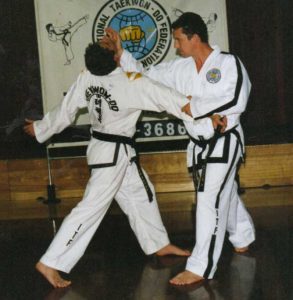Close Range Taekwon-Do Techniques

Whilst we commonly associate high kicking and ‘tournament sparring type’ movements with Taekwon-Do, most of these techniques are performed at long range (i.e. at full extension), it is vital that students and instructors do not overlook close range techniques.
Taekwon-Do, after all, was originally developed by General Choi Hong Hi, as a form of unarmed combat for the purpose of self-defense.
Self-defense situations, as we all know, are most likely to be at close range. That is, it is not always possible or practical to throw ‘flashy’ stereotyped Taekwon-Do kicks due to the close proximity of your attacker.
Many high ranking Taekwon-Do practitioners and successful tournament ‘fighters’ often come unstuck in ‘real’ situations because they cannot distinguish between modified tournament techniques and situations, and technically correct self defense movements to create maximum force and immediate results. Or perhaps their instructors have misled them into believing that tournament training alone will get them by in a real-life self-defense situation.
The Human Body as a weapon
The body has a series of weapons, or attacking tools, which one can utilize for both attack and defense situations.
The appropriate selection of your weapon will be determined by a number of factors including, location of targets available, angle or direction of attack, and the distance of your assailant in relation to you.
Factors to be considered include:
Attacking tools available for your use
Targets available to attack
Distance from attacking tool to target
Attacking Tools
Whilst we concentrate mainly on techniques which involve full range of our arms and legs, we can shorten them for close range self defense.
By using similar actions, we can adapt common techniques.
For example, front kick can be performed with the knee as the attacking tool, rather that the foot.
Front strike can be performed with the elbow, rather than the fist.
Other close range hand techniques include Upset punch (uppercut in boxing terms) to the body or chin, Palm heel strike to the chin or philtrum, Angle punch (or hook) to the body or face.
Your attacking tool needs to be carefully selected according to the required task.
For example, a poke in the eye with one or two fingers will do more damage than a forefist punch to the eye, due the greater amount of pressure concentrated to a small point of attack.
Attacking tools can include: forefist, back fist, side fist, knife hand, reverse knife hand, fingertip, ball of foot, heel, foot sword, instep, knee……etc.
Vital Spots & Pressure Points
Consider also the targets available. At close range your attacker usually means business and you don’t have the opportunity to ‘play sparring’ with him, so your choice of targets needs to be appropriate to create severe pain or temporarily (even permanently, if necessary) disable your attacker to allow you to create your escape.
Knowledge of vital spots and pressure points is essential, as well choosing the appropriate tool for the job.
Vital spots are basically areas which are not protected or cushioned by a thick layer of muscle, when struck with sufficient force and the appropriate tool, serious injury can occur.
Vital Spots include temple, philtrum, eyes, throat, solar plexus, base of skull, spine, pubic region, sternum, jaw, point of chin, floating ribs, collar bone, bridge of nose, neck artery, coccyx, knees…..etc.
Basically, pressure points are the thousands of nerve junctions which effect the function of the muscles or body parts associated to them. The nerves are the brain’s messenger network to the rest of the body, by interfering with that information process by striking or applying pressure to the nerve, you can create an involuntary reaction from your attacker.
Some easy to access pressure points for close range self defense can be located at the philtrum, behind the mandible, on the sternum, behind the clavicle, on the tricep tendon, on the brachial muscle (forearm), the inside of the quadriceps…etc.
At close range, your reaction time needs to be fast, and the techniques you choose need to be effective.
Distance
The distance of your opponent from you has a large bearing on the attacking tool and target you select.
To produce maximum power, Taekwon-Do techniques must be performed in the appropriate body posture (i.e. stances), with transfer of body weight, sine wave…etc.
At close range it is frequently difficult to create full stances, so the body needs to compensate or create an opening with an initial attack to a vital spot.
Because you are often unable to travel in a forward direction, particularly when being held by a larger person, you downward transfer of body weight is of utmost importance, to effect the balance of your attacker.
Also, sometimes a backward motion, allowing the attacker to come forward and using their own force and momentum to execute a sweeping or take-down action is necessary.
Effective self defense incorporates many concepts, including releasing, striking vital spots/pressure points, shifting body weight to effect balance.. etc.
 written by Master Michael Muleta, 8th Degree
written by Master Michael Muleta, 8th Degree
- President – United ITF Taekwon-Do Australia
- CEO – Global Fitness Institute
- Level 3 First Aid Instructor

